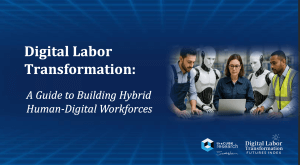 A Journey to the AWS Cloud
A Journey to the AWS Cloud
IT pro Jake Burns stopped by theCUBE studios recently to share his story about a journey to the AWS cloud. Jake is Vice President of Cloud Services at Live Nation Entertainment, based in Los Angeles, CA. As head of cloud services for the company, Jake and his team are in charge of infrastructure for IT, including cloud infrastructure, as well as the move to the cloud, which was completed in early 2017. He’s also responsible for enterprise messaging, which includes corporate email, DNS, database services and storage management.
Cloud Push: Top Down or Bottom Up?
I asked Jake where the impetus came for taking a journey to the AWS cloud– was it from the corner office– “thou shalt move to cloud;” or was it an IT-led initiative? He told me it started off as a bottom-up push. For a number of years he had wanted to get the company involved in public cloud, at least at some level. But, it really didn’t take off until the CEO put forth a mandate to get 100% to the public cloud. This came in 2015, catalyzed by a goal to modernize all of IT.
The IT staff was happy with the push. They had spent a lot of time managing infrastructure and data centers, and according to Burns, “it just wasn’t part of our core business…We wanted to focus more on satisfying the business, and providing value…our time could be better spent really helping solve problems, rather than deal with hardware and systems.” The other factor cited was business agility in general. If the company wanted to stand up a new system, the typical lifecycle could be three to six months, just to get an application up and running. With AWS cloud, according to Burns, the organization can now do that in days, or at the worst case, weeks. The net of it was being able to respond quickly to business needs is something that’s really important to the company, and they saw with the AWS public cloud, IT work could be accomplished much more efficiently.
Big Technology Change Required New Skills
Burns realized very early on that this was a big technology change for the company. It was going to require new skills that weren’t present in the organization. Across-the-board training became a big priority. The company tapped experts from AWS. Much of the training was done at company offices. Burns and his team went through virtually every training program that AWS offered. They became certified. They also made sure they really understood what the journey to the AWS cloud was going to be all about before getting started. This was an important early step.
Addressing Resistance from the IT Staff
According to Burns, in the beginning, there was resistance from the internal IT team. With projects like this, people are concerned they’re going to lose their jobs. The fear from IT was they were being outsourced. Specifically, the company is moving all of its infrastructure and taking a journey to the AWS cloud. The reaction was “this is our job…We’re managing hardware, we’re managing servers, we’re managing data centers, and all that stuff’s going to go away, so what are we going to do?” So before the training, the priority for Burns was to get people to understand that this is not something that’s a danger to careers. Rather taking a journey to the AWS cloud is going to make people more valuable. Burns stressed to his people that they’re going to get trained on cloud technology. He convinced his people that the real world experience was invaluable. That moving a Fortune 500 company to the cloud is still going to require staff to maintain IT. He stressed, “not only will you have job security, but you’re probably not going to care about job security at the end of this, because you’re going to be so valuable in the marketplace.”
Timetable on the Journey to the AWS Cloud
I asked Burns how long he thought this would take. He said the target was twelve months to move:
- 668 servers
- 118 applications (including Oracle, SAP and some other mission critical apps)
Ninety percent of this was accomplished in twelve months. Then it took an additional five months to move everything else, including the Oracle apps – 17 months in total for the move.
The strategy was to move the easy stuff first – like Web and single server apps, monitoring systems and other systems controlled exclusively by IT. Learn from this, then attack the long tail of more business and mission critical workloads.
Some Challenges with AWS Storage
Burns shared with me that AWS isn’t necessarily designed for enterprise applications. One area in particular was storage. While AWS storage, especially S3 is solid, according to Burns, most enterprise applications can’t utilize object stores. Rather they want block storage. Burns said AWS’s Elastic Block Storage is different than what data centers typically use. So applications like Oracle can be a challenge and often expensive to get working properly.
Burns brought in a software company called Actifio to solve this problem. Actifio, according to Burns, allows you to virtualize storage in AWS– essentially mimicking the way traditional storage works in a data center environment. Specifically, Burns said his team was able to take snapshots and clones in a way they couldn’t with AWS natively.The business impact of this move was simple – save time and money. According to Burns, they key factor was not having to change workflows. In other words, while they changed the technology, some of the people skills and processes remained.
Advice for Peers Taking a Journey to the AWS Cloud
Burns had the following recommendations for his peers.
- Invest in your people
- Focus on cost savings from day one– not after the fact
- Don’t get sucked into fancy methodologies
- Beware of sales pitches that distract from your core mission– everyone’s trying to sell you the best way to do it
- Beware of adding complexity – keep it simple
- Focus on the outcome – don’t ever lose site of that
- Don’t forget to plan for what happens after you’ve made the move to the public cloud
- Prepare for the endgame– it’s different and requires a new mindset.
I want to thank Jake Burns for spending time with us in our studios. He’s become a great contributor to our community and is a terrific resource.
Watch the entire interview below. There’s a ton more information in the video clips than what I covered in the blog post. Especially interesting is how Burns and his team accomplished this with no additional budget. And importantly, how he dealt with the challenges associated with moving Oracle onto AWS– especially the licensing.
I’d love to know what challenges you’ve faced on your journey to the AWS cloud. Reach me on Twitter @dvellante.



